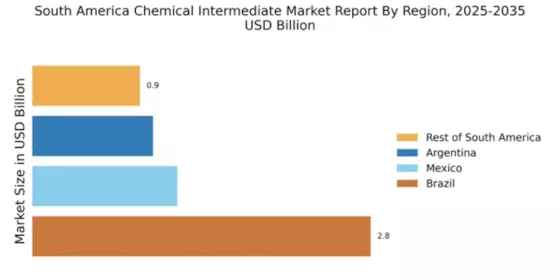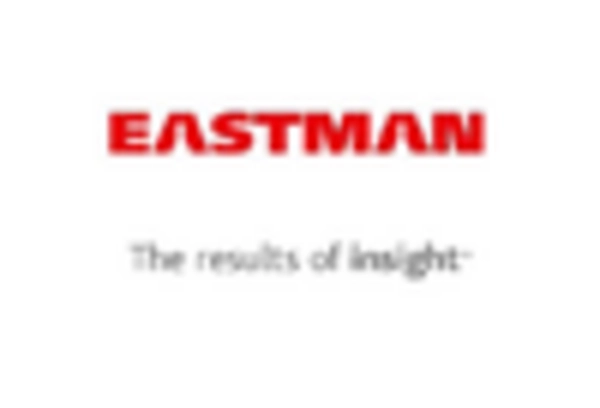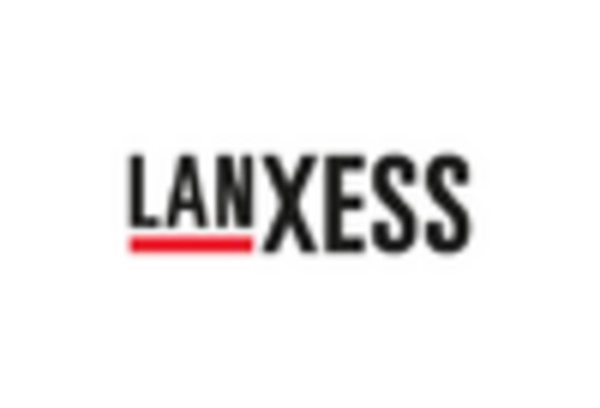Rising Demand for Agrochemicals
The chemical intermediate market in South America is experiencing a notable increase in demand for agrochemicals, driven by the region's agricultural sector. With agriculture being a cornerstone of many South American economies, the need for fertilizers and pesticides is paramount. In 2025, the agrochemical market is projected to reach approximately $12 billion, indicating a growth rate of around 5% annually. This surge is likely to stimulate the chemical intermediate market, as these products serve as essential precursors in the production of agrochemicals. Furthermore, the trend towards sustainable farming practices may lead to the development of bio-based agrochemicals, further enhancing the demand for specific chemical intermediates. As such, the interplay between agricultural growth and chemical intermediates is expected to be a significant driver in the region.
Increased Focus on Renewable Energy
The shift towards renewable energy sources in South America is influencing the chemical intermediate market. As countries in the region aim to reduce their carbon footprints, there is a growing emphasis on biofuels and other renewable energy technologies. The renewable energy sector is expected to grow at a CAGR of around 8% through 2025, creating a demand for chemical intermediates used in the production of biofuels and bioplastics. This transition not only aligns with global sustainability goals but also presents opportunities for local chemical manufacturers to innovate and diversify their product offerings. The interplay between renewable energy initiatives and the chemical intermediate market suggests a potential for growth, as companies adapt to meet the evolving energy landscape.
Infrastructure Development Initiatives
Infrastructure development initiatives across South America are poised to bolster the chemical intermediate market. Governments in the region are investing heavily in infrastructure projects, including transportation and energy, which are essential for the efficient distribution of chemical products. In 2025, infrastructure spending is projected to exceed $200 billion, with a focus on enhancing logistics and supply chain capabilities. Improved infrastructure not only facilitates the movement of raw materials and finished products but also attracts foreign investment in the chemical sector. This influx of capital can lead to the establishment of new chemical plants and the expansion of existing facilities, thereby increasing the production capacity of chemical intermediates. Consequently, the growth of infrastructure is likely to serve as a catalyst for the chemical intermediate market.
Emerging Market for Specialty Chemicals
The emergence of a market for specialty chemicals in South America is likely to drive growth in the chemical intermediate market. Specialty chemicals, which are used in a variety of applications including personal care, electronics, and automotive, are gaining traction due to their tailored properties and performance. The specialty chemicals market in the region is projected to grow at a CAGR of approximately 6% by 2025, reflecting a shift in consumer preferences towards high-performance products. This trend is expected to increase the demand for specific chemical intermediates that serve as building blocks for these specialty products. As manufacturers respond to this evolving market landscape, the chemical intermediate market is poised to benefit from the rising interest in specialty chemicals.
Expansion of Pharmaceutical Manufacturing
The pharmaceutical sector in South America is undergoing rapid expansion, which is likely to have a profound impact on the chemical intermediate market. As of 2025, the pharmaceutical industry in the region is estimated to be valued at over $40 billion, with a compound annual growth rate (CAGR) of approximately 7%. This growth is primarily fueled by increasing healthcare needs and a rising population. Chemical intermediates play a crucial role in the synthesis of active pharmaceutical ingredients (APIs), and as the demand for innovative drugs rises, so too does the need for these intermediates. The expansion of local manufacturing capabilities, coupled with investments in research and development, suggests that the chemical intermediate market will benefit significantly from the pharmaceutical industry's growth trajectory.


















Leave a Comment